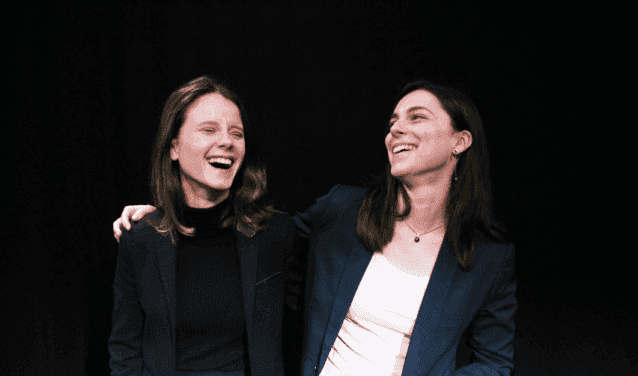Home>"From history to herstory": a new look at old galleries

20.07.2020
"From history to herstory": a new look at old galleries
Cécile Fara and Julie Marangé met on the first day of their Master’s degrees at Sciences Po. Together they founded Feminists of Paris, an organisation that offers walking tours and museum visits ‘through the lens of feminism and gender equality’ in Paris, Lyon, and Bordeaux. Cécile and Julie spoke to us about their entrepreneurial experiences with Feminists of Paris and how the history of feminism in France resonates today.
Can you tell us about Feminists of Paris; what is it, and what are its principal objectives?
Feminists of Paris offers 11 feminist walking tours in Paris, Lyon and Bordeaux, in both English and French. Our goal is to address gender-related issues through art and culture and to cast light on the powerful and inspiring women who have been forgotten or erased from history. In a sense, we go from history to herstory, and develop a different narrative than the one we have been taught at school.
Our walking tours allow curious locals and tourists to discover the empowering street art of the Butte-aux-cailles neighbourhood, to visit the Latin quarter whilst hearing about the witch hunt, or to learn about art history through a feminist lens at the Louvre.
What made you want to start up an initiative such as Feminists of Paris?
Both of us spent some time in the United Kingdom: Julie did her undergraduate studies at the University of Bath and Cécile graduated from the dual degree between Sciences Po and University College London. We majored in gender studies, and were active in feminist societies at university. Meeting during the first week of our Master’s, we shared the feeling that it was more complex and taboo to talk about feminism in France than across the Channel. We thus decided to start our own project, which would address gender equality through the prism of art, history and culture, and allow for instructive and constructive conversations around this issue.
When you meet people on your tours, do you feel positive about the state of feminism and feminist education in France?
Offering our walking tours in English has given us the opportunity to meet people of 39 nationalities. Many of them had an idealised vision of the French society, believing that gender equality was a reality in France. Through our two-hour tours, they get a more complex understanding of French society and history, whilst visiting the city in a novel and “off the beaten path” way. For example, at the Père Lachaise Cemetery, we tell the story of Rosa Bonheur, a 19th century animal painter, who had to ask for a cross-dressing permit so that she could wear trousers to the slaughterhouses where she found her inspiration. This gives a unique insight into the obstacles women had to overcome in order to fulfil their dreams. We put historical examples into perspective by drawing parallels with modern society: today, 60% of graduates from the Beaux-Arts are women, but only very few of them receive the same recognition as men.

For you as educators, what have been the greatest takeaways from these tours? What feedback have you received? What have you learned?
Each day, through our research, we discover the stories of female scientists, writers, politicians, artists, whom we had never heard of before. It’s really fascinating. Their destinies are illustrations of gender inequalities and historical mechanisms, which cause the erasure of women. We intend to give them more room in history by telling their story during our tours. This empowers participants as it gives them real-life examples and all the more reasons to believe that they too can follow their dreams, regardless of their gender and societal pressures. Most of them tell us that, thanks to our tours, they see the urban space and visit museums differently. They are always on the lookout for engaged street art and look up the women lucky enough to have a street named after them.
Could you give us an example of a work that takes on a different meaning when we view it through a “feminist lens” or which, conversely, has itself contributed to the feminist movement?
During our feminist tour of the Louvre, we look at Mona Lisa through a feminist lens. This portrait by Leonardo da Vinci, from 1503, is the most famous in the world, but what does it tell us about women at the time? The feminine ideal was sobriety, modesty, aligning with representations of the Virgin Mary. The dark veil that covers Mona Lisa's hair can be considered a mourning veil, but such veils were commonly worn as a mark of virtue. She is also known as La Gioconda, which actually means “the wife of Francisco Giocondo”: it is striking that this woman, who entered art history, is still recalled by her husband’s name.
Is there a message you hope for everybody to take away from your tours? What’s something you wish you could say to all women, or to everybody, who you aren’t able to reach directly through Feminists of Paris?
We wish for everyone, regardless of their gender, to see feminism, the movement for gender equality, as a necessity rather than a threat. We wish for women to be able to follow their aspirations and to inspire them with the stories of role models. This year, we are opening new tours in other French cities, so that even more people can join and enjoy them!
This time of confinement is an opportunity to learn more about feminism and our feminist culture. We recommend essays and feminist novels, podcasts and online exhibitions that we then comment, critique and share on our social media (Facebook, Instagram and LinkedIn) and on our feminist blog!
Related links
- Fempo: period-proof underwear made in Sciences Po
- Goodbye plastic, hello Koovee
- Nomadher: the app for female globetrotters made in Sciences Po
- A Career path that makes sense
More information